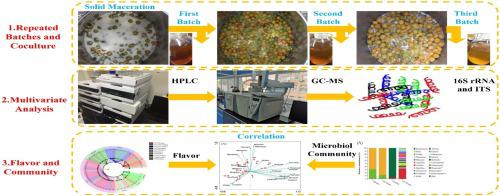Process Biochemistry ( IF 4.4 ) Pub Date : 2021-06-19 , DOI: 10.1016/j.procbio.2021.06.016 Jian Liu , Miao Liu , Pian Ye , Cheng He , Yingjie Liu , Suyi Zhang , Jun Huang , Jun Zhou , Rongqing Zhou , Liang Cai

|
This study aimed to investigate the effect of repeated batch fermentation of cocultured Saccharomyces bayanus Y4 and Torulaspora delbrueckii Y7 on the quality of greengage wine. The acidity, as well as citric acid and L-malic acid content, decreased significantly with the batches. The citric acid content of the single culture in each batch was 58.59, 26.27, and 8.45 g/L, respectively. Additionally, the ester content increased with the batches. The respective values were 1627.93, 2249.46, and 2491.17 μg/L for the prophase of coculture. However, volatile content in the fresh wine of Y4 yeast in each batch was high. Ketone and terpene contents in the first batch of coculture significantly increased from 31.64 to 95.60 μg/L and 58.58–95.13 μg/L, respectively. Furthermore, a significant difference was observed between the microbial communities fermented using single culture and coculture. The change in fungal community diversity for coculture pattern was higher than that in the mash-inoculated single strain, which decreased the abundance of dominant fungi. Pichia, Stropharia, Suillus, Malassezia, Trichoderma, Faecalibacterium, and Butyricicoccus were associated with esters, terpenes, phenylethyl alcohol, and β-ionone. Our study provides a new avenue to improve the flavour and quality of wine brewed using a characteristic fruit.
中文翻译:

重复批次和共培养发酵青梅酒的代谢物谱和微生物群落的表征
本研究旨在研究共培养巴氏酵母Y4 和德氏圆孢菌的重复分批发酵效果。Y7 关于青梅酒的质量。酸度以及柠檬酸和 L-苹果酸含量随着批次的增加而显着降低。每批单一培养物的柠檬酸含量分别为58.59、26.27和8.45 g/L。此外,酯含量随着批次的增加而增加。共培养前期分别为1627.93、2249.46和2491.17 μg/L。但各批次Y4酵母鲜酒挥发分含量较高。第一批共培养物中酮和萜烯的含量分别从 31.64 到 95.60 μg/L 和 58.58-95.13 μg/L 显着增加。此外,观察到使用单一培养和共培养发酵的微生物群落之间存在显着差异。Pichia、Stropharia、Suillus、Malassezia、Trichoderma、Faecalibacterium和Butyricicoccus与酯类、萜烯、苯乙醇和 β-紫罗兰酮有关。我们的研究为改善使用特色水果酿造的葡萄酒的风味和质量提供了新途径。



























 京公网安备 11010802027423号
京公网安备 11010802027423号